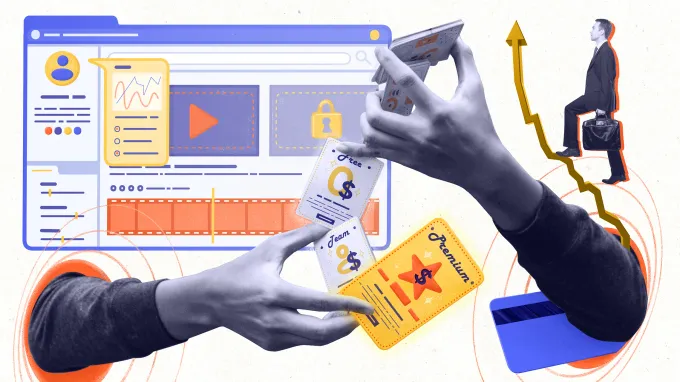What is a SaaS Business Model and How Does It Work?
- The Software as a Service business model charges users to access and use an application hosted on external cloud servers.
- The Software as a Service model offers a lot of benefits for users, including reduced costs, scalability, and accessibility. Due to its popularity, software creators who choose the SaaS model have a high chance to succeed with their product.
- There are six possible SaaS business model pricing options to monetize your SaaS product: freemium, flat, usage-based, per-user, tiered, and hybrid pricing. Your choice should be based on your product’s specifics.
- There are three options on how you can bring your SaaS business idea to life: start working on the idea on your own and get software development consulting if needed, hire an internal team and a chief technology officer, or outsource product development to a third party.
If you are looking for information about the SaaS business model, you are probably thinking about creating your own subscription-based startup. Knowing the fundamentals before you start planning your startup is extremely important to understand how the SaaS model can power your business and how you can benefit from it.
Stories of such successful SaaS companies as Salesforce, Shopify, and Zoom prove that the SaaS business model works and will continue to stay indispensable for a long time to come.
So, what is a SaaS business model? Why SaaS is the best business model for most startups (including those that are only starting and those with an established user base)? What are SaaS business model benefits and revenue streams? In this article, we will give comprehensive answers to these questions.
Introduction to SaaS
The emergence of SaaS as we know it today started to take shape in the late 1990s, when the idea of Application Service Providers (ASPs) started to gain popularity. ASPs provided services like hosting, managing, and delivering business applications and services to customers over the internet. However, at that time, this concept faced serious challenges associated with security concerns and limited internet infrastructure.
In the early 2000s, when internet bandwidth improved, the ASP model evolved into what we now call Software as a Service (SaaS) — a delivery model that makes software accessible online via subscription. Salesforce and NetSuite were among the first companies to offer SaaS solutions.
At that point, SaaS started to become a mainstream delivery model. Companies that offered their software products with a traditional, on-premises model started migrating to SaaS, appreciating its cost-effectiveness, scalability, and accessibility. Now, SaaS has almost completely replaced the traditional on-premises software delivery model.
What is the SaaS business model?
The SaaS business model involves selling software products as a service instead of selling licenses for on-premises software instances.
In short, the distinctive features of SaaS are:
- hosting on cloud infrastructure
- subscription-based pricing
- regular updates and maintenance from the provider's side
SaaS revolutionized software delivery, offering various benefits for both users and providers. However, what can SaaS offer as a business model?
There are two major types of SaaS business models: the B2B SaaS business model and B2C SaaS business model. You should learn more about these types when deciding on the target audience for your SaaS startup.
B2B SaaS business model
B2B SaaS, or the business-to-business model, involves SaaS companies selling software products to other businesses on a subscription basis. Companies use B2B SaaS products to optimize their internal processes and effectively achieve business goals. For example, many businesses use software like Slack or Zoom for communication, services like Mailchimp for email marketing process automation, etc.
The story of B2B SaaS apps often starts when companies decide to build custom software to solve their internal needs. When the primary goal is achieved, businesses realize their problems are not unique and that many other companies around the world strive for a similar solution. That’s the point when they decide to turn their internal software into a SaaS product to sell it to a wider audience.
For example, one of our clients, the owner of a marketing agency, asked us to build a custom all-in-one SMM platform for managing the agency’s everyday tasks. We had to build a tool to meet the internal needs of our client’s team (such as an improved content approval process) and provide integrations with social media services like X (previously Twitter), LinkedIn, Instagram, and Facebook. Then, our client decided to create a SaaS product that would help other marketing agencies solve similar problems. When we successfully completed the project, our client managed to attract investors to fund further development of a platform version developed by the Clockwise team.
B2C SaaS business model
B2C SaaS, or the business-to-customer SaaS business model, refers to SaaS products that target individual, non-business consumers. These are products we use in our everyday lives: cloud storage services like Dropbox, music streaming services like Spotify, meditation apps like Headspace, and so on.
If you want to launch a B2C product, your startup will need to closely interact with users. While in the case of a B2B service, the requirements of your target audience are somewhat obvious, catering to the needs of each individual user of a B2C service requires more attention. You need to constantly monitor customers’ feedback and be ready to upgrade your product accordingly.
Let’s consider Spotify as an example. This music streaming service is used by casual listeners, fitness enthusiasts, podcast lovers, DJs, and music explorers. It would be impossible to make Spotify equally convenient for such a diverse group of users without listening to their feedback.
Peculiarities of SaaS products
To give you a better understanding of what the SaaS business model is, we will describe five features inherent to the vast majority of modern SaaS products.
Pay-as-you-go pricing model
The most widely known feature of SaaS is the pay-as-you-go model (or subscription-based model). Basically, this is what SaaS business model is all about: users pay for your software product as a service instead of buying a perpetual license for it.
In most scenarios, this consumption-based model is more convenient than other pricing models, allowing users to align expenses with operational needs. You can establish the value for features and resources used and bill users accordingly.
Cloud infrastructure
SaaS applications are typically hosted in the cloud. Basically, this means that the data is stored on remote servers maintained by a cloud provider. This eliminates the need for users to install, manage, and maintain the software on their own.
The terms “cloud application” and “SaaS application” are frequently used interchangeably, but there's a key distinction. A cloud application simply hosts in the cloud, while a SaaS application is not just in the cloud; it's delivered to users via a subscription-based pricing model. If you want to find out more on this topic, proceed to reading our SaaS vs cloud article.
You as the product owner can choose a reliable cloud provider for your application instead of having to invest in your own hardware and infrastructure. This will allow you to pay only for resources used and scale up and down with ease. In addition, cloud hosting is widely available nowadays, and you are free to choose from dozens of providers. The most popular cloud service providers are Amazon Web Services (AWS), Microsoft Azure, and Google Cloud Platform (GCP).
Integrations
SaaS products can be used as a suite of services rather than one separate service, since they are designed to be integrated with other applications. You can integrate your SaaS application with third-party services with the help of an API (application programming interface) —intermediary software that allows applications to communicate with each other.
Consider HubSpot — a world-known SaaS platform for inbound marketing, sales, and customer service. HubSpot integrates with hundreds of services including CRM systems, email marketing tools, analytics tools, e-commerce platforms, and social media apps.
Users can seamlessly transfer data between their existing applications and a new SaaS service when they adopt the latter. This involves integrating the new service with their established tools, allowing for smooth and efficient data exchange. Moreover, as a SaaS provider, you can enhance and enrich your app’s functionality by connecting it to other software without the need to develop features from scratch.
Multi-tenant and single-tenant architecture
Applications built according to the SaaS business model often use a multi-tenant architecture, where multiple users share common infrastructure but are isolated from each other, or a single-tenant architecture where users get dedicated resources and greater customization possibilities. These architectures are considered particular to SaaS products, as they are designed to meet users’ specific requirements.

Email services like Gmail, for example, are used by many users, but each has their own email account. Accounts use the same infrastructure while still being separate. For Gmail, a multi-tenant architecture allows for efficient use of resources: instead of dedicating separate infrastructure to each user, resources are shared dynamically, making the system scalable and cost-effective. On the other hand, for an enterprise CRM system, for example, a single-tenant architecture makes more sense. In this case, each user has their own isolated instance of the application, with dedicated resources and customization options.
SaaS business model examples
To help you understand what we mean when talking about SaaS businesses, we’ve compiled a list of the most successful Software as a Service products. You likely use some of them almost every day.
Google Apps
Everything from the good old Gmail system to scheduling events on your calendar is hosted on a cloud service. For example, you can easily access your Google Photos or check your email from wherever you are.
If you are not a member of Team Google, Dropbox is a good SaaS alternative for storing files and images. Once you add a new photo to your Dropbox account, it can be accessed by any desktop or web-based application with a Dropbox integration.
Slack
Slack is a great tool for team communication offered as a cloud-based software product. Slack messages are secured and the entire system is built on a cloud service.
Amazon Web Services
Amazon Web Services is now a pack of more than 70 cloud-based apps that cover analytics, app integration, cost management, development needs, etc.
Zendesk
If you strive to provide clients with flawless service, you have probably employed Zendesk for your support needs. Would it be surprising if we said it uses the SaaS business model too?
If you are looking for some inspiration, check out our article about the top fast-growing SaaS startups.
Advantages of the SaaS business model
Not sure whether you should create your own application following the SaaS business model? In this part, we tell you about the advantages that it can bring to you as a business owner and how it can be beneficial in terms of meeting the needs of your potential customers.
SaaS business model benefits for vendors
Let’s take a look at them:
Recurring income
SaaS business model is probably the most suitable one for those who dream of stable profit from their startup. With a SaaS product, you attract a new user once and can count on a number of recurring payments from them. Working on retention and satisfaction of the existing customer base is challenging, but in this case, you can focus on building long-term relationships. In addition, the recurring SaaS revenue model promotes better returns on investment due to a predictable and stable cash flow.
Cost-efficiency and easy scaling
Since most SaaS products are hosted in the cloud, you use the provider’s infrastructure resources without the need to buy and configure your own hardware. Also, scaling (adding new features or handling an increased flow of users) is effortless and doesn’t require you to invest a significant amount of money for upgrading your own infrastructure.
Bigger market share
With a product built according to the SaaS business model, you can cover a major market segment. You can do this by providing various pricing plans to cover moderate needs of individual users and the needs of businesses of different sizes.
You can also grow along with your customers: an entrepreneur who uses the first basic version of your app to start their own small business may eventually become the CEO of an enterprise, while your startup may turn into a platform with a comprehensive suite of services for businesses of all sizes.
Customer loyalty
SaaS products gain a loyal user base because of their quality, features, and regular updates they provide to please customers. But these aren’t the only reasons why customers stay committed to SaaS products.
When a SaaS product serves business needs and responds in a timely manner to new industry challenges, it usually becomes an integral part of companies’ internal processes. Thus, even when a better analog of the product appears on the market, companies are not likely to spend time and resources on replacing what they already have.
This will allow you as a SaaS vendor to build a loyal customer base and retain relationships with customers that are ready to invest in your service for years and years, receiving predictable and stable revenue.
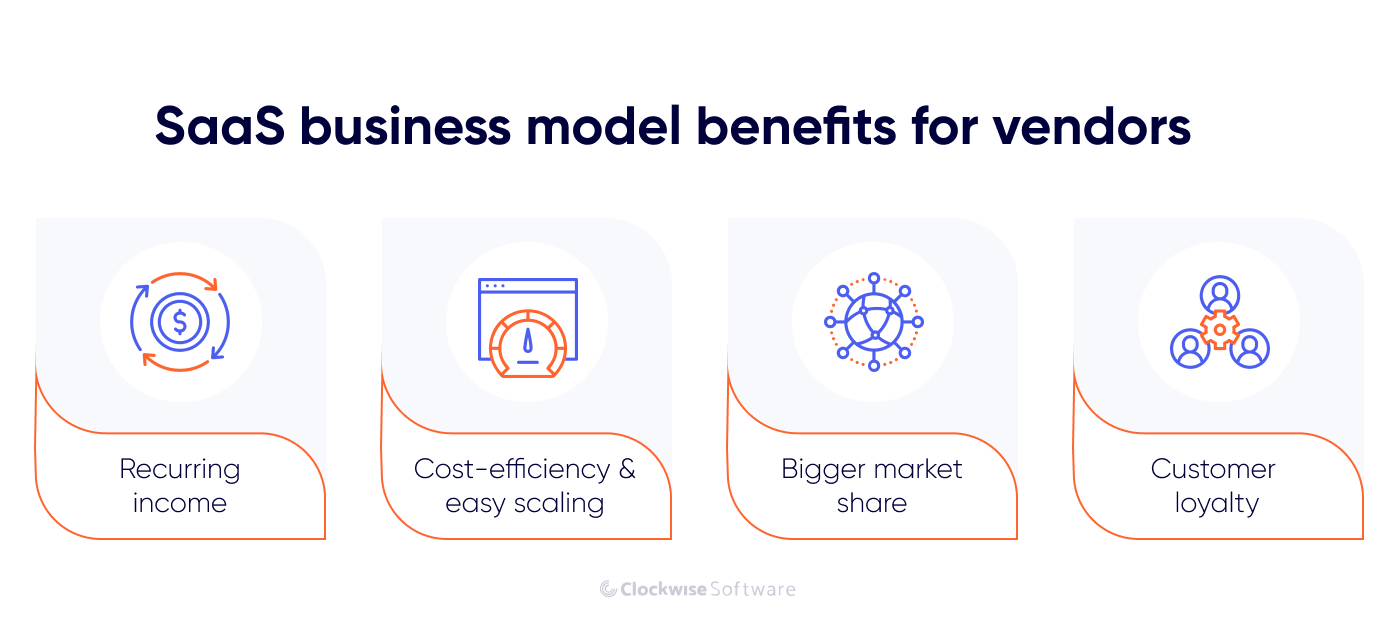
SaaS business model benefits for users
Understanding SaaS business model benefits for users is important if you want to create a user-oriented product. Moreover, benefits for users directly influence the success of this business model and therefore the revenue from such projects.
Here’s how benefits for users become benefits for SaaS developers:
Price flexibility
Users often choose SaaS products for their affordability. You can find a SaaS solution for any need and budget. Some SaaS products appear to be expensive even for very successful businesses (for example, the licensing cost of SAP S4HANA, a cloud-based ERP system, can reach $100,000 per year), but it’s always a matter of scale. However, the price flexibility offered by the SaaS business model is what will allow you to attract more customers by covering the needs of different user groups.
Customers can use a free trial or pay for a one-month subscription to assess the benefits of your product, or they can choose from different pricing plans, ranging from basic to advanced, before fully committing to your service. All this will allow you to expand the boundaries of your potential user base.
Choosing the right way to provide price flexibility for your customers is one of the keys to success. Later in the article, we talk about how to do so in detail.
Easy adoption
Since products built according to the SaaS business model are available via a browser or can be installed in a few clicks, user onboarding is mostly hassle-free. If a user is a business owner who needs a particular app to enhance business processes within the company, they normally won’t need to dedicate a lot of time to educating team members. The majority of SaaS apps are built to be as user-friendly and intuitive as possible, providing manuals and tutorials to reduce the time required for users’ onboarding.
SaaS services don’t require complex setup and education, allowing you as a product owner to attract and retain more customers.
Accessibility
SaaS products can be accessed from any device that has a web browser and an internet connection, unlike on-premises software whose accessibility is limited to certain devices. The accessibility of SaaS products becomes vital for remote work scenarios, where multiple workers need to access the same document or project and make changes to it in real time.
Thanks to SaaS accessibility, you as a product owner can provide clients with flexibility so they can access software from any device.
Integrations
Thanks to seamless integrations with other services, users can benefit from smooth and efficient work. For example, let’s say you use Trello to organize your tasks and Slack to communicate with your team. Integration between Trello and Slack means that you can receive notifications in your Slack channel whenever a task is completed in Trello, making it easier for you to stay updated without having to switch between applications.
Third-party integrations in your SaaS product will contribute to increased user satisfaction. The main concern here is to understand the true needs of your target audience and provide users with useful integrations: this way, your users won’t have any reason to look for alternatives.
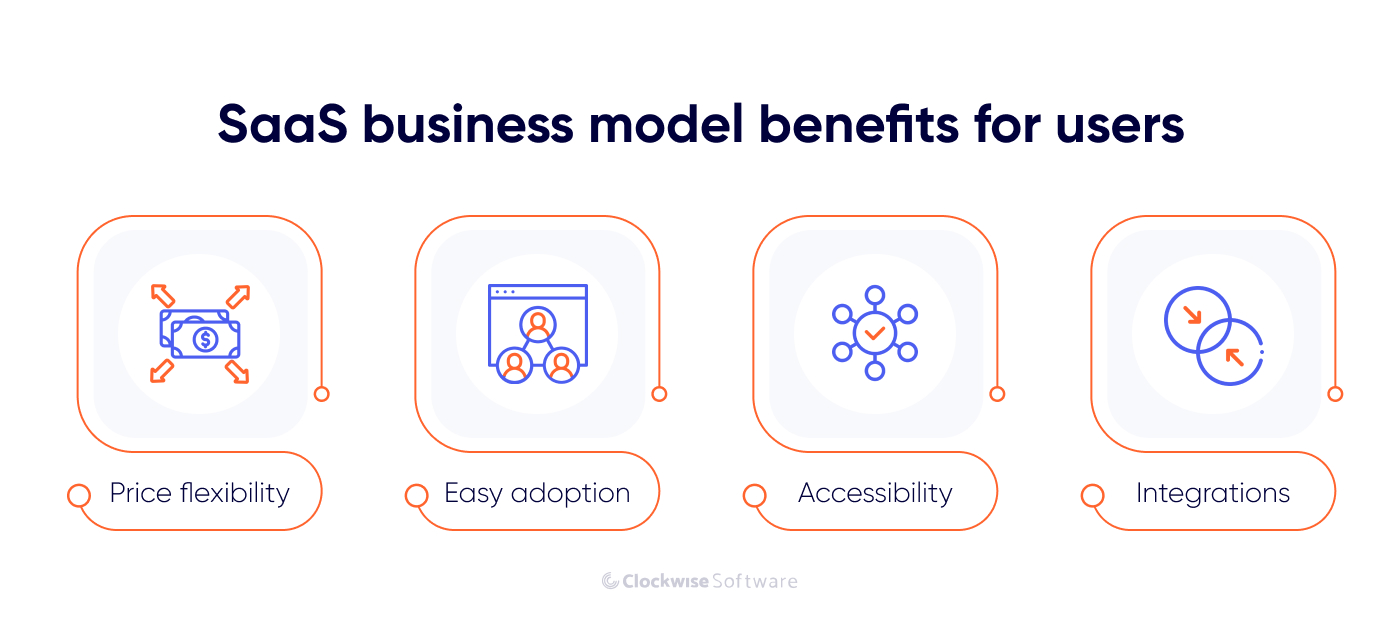
SaaS business model challenges
With all of its benefits, SaaS also comes with some challenges that you can’t ignore if you want to create a successful startup.
Investment challenges
Desiring to start a SaaS startup from scratch, most founders search for ways to minimize resources and investments needed for the initial product version. From our experience, developing a solid SaaS product MVP requires $100,000 at minimum. Considering all the risks associated with startup creation, investing this amount in development can be challenging, especially if you don't have experience launching startups.
Moreover, no SaaS product can be considered a cash cow that brings stable passive income by default. In order to keep growing — and just to operate day to day — a startup requires significant capital. And here is another challenge associated with investments: even if the first version of your startup gains some success, it may still not be enough to attract investment for refining your app.
As a SaaS application development company, we have broad experience in SaaS development. When a client approaches us with the intention to create a SaaS product (or turn an existing app into a SaaS product), we start from a project discovery phase, which includes market research, idea validation, risk identification, and many other processes. Thanks to this, our clients are able to see how viable their ideas are, the main risks associated with their projects and ways to overcome them, and how to properly allocate their resources. Investing in discovery means increasing your chances to release a successful product. Once a product has proven value, it becomes much less risky to invest in its scaling. Also, a properly executed project discovery phase may help you attract potential investors, as they will be able to evaluate the project’s prospects as well as your determination to bring your project to life.

Competition
When you sell your software product on a subscription basis, you have to provide nearly flawless service. Otherwise, your users may start comparing your product with alternatives. In addition, you should pay attention to competitors that can lure your audience — both existing competitors and those that may appear in the future.
You should consider launching an app as only your first step in launching a SaaS business. The next step is to maintain it. For this, you will need a long-term development and support team that will take care of fixing bugs, keeping users’ data safe, adding new features in accordance with users’ demands, and providing necessary system upgrades.
In order to deal with competition challenges, you need to build your development process in an adaptive way, being ready to respond to changing market conditions and user needs. At Clockwise Software, we organize development according to an Agile methodology that is focused on iterative and incremental practices, adaptive planning, continuous improvements, and early delivery. The last item is achieved by building an MVP: a basic app version that has a minimal set of features — just enough to be evaluated by the first users.
Thanks to such an approach, we can make sure that further development (after the MVP launch) will be based on real users’ feedback, not assumptions or predictions. If you deliver a service your users truly need, they won’t have any reasons to look for alternative SaaS products. This way, we minimize risks associated with market acceptance and high competition.
SaaS revenue model: How to monetize your startup?
In this section, we explain how to choose the proper SaaS revenue model to monetize your product.
Freemium
Freemium is a SaaS revenue model that allows users to access a certain set of features for free. This model works because it allows every potential user who is interested in a product to get hooked on it and have a positive experience with it. Freemium can be considered the best way to prove product–market fit and “buy” customers.
Some startups, like Flickr (an image and video hosting service), implement an ad-supported strategy and charge users only for an ad-free package with more features. Advertising allows you to monetize an application even when users use it for free.
Other startups may allow everyone to try out their basic tier with certain limitations that can be removed for a fee. For example, Slack lets free users access the most recent 10,000 messages in their archives. However, users with paid plans have unlimited access to their message history. This way, Slack allows small teams to use the service for free. They get used to the service, know all its benefits, and don’t want to give up Slack as they grow and hit the limit. At that point, they are ready to pay to keep using the same convenient work environment.
Using this model and providing your basic services for free will allow you to gain a solid user base and expand your market presence. However, you should also consider the nature of the SaaS product you are planning to create before deciding that this monetization strategy will work for you.
Products like communication tools that benefit from a large number of users can take advantage of the freemium model. At the same time, for complex SaaS startups whose products have a steep learning curve, as well as for those that require high support and maintenance costs, freemium isn’t the most suitable model.
Why is freemium attractive for users?
- Free access. Users can assess an app’s benefits using a basic version without any upfront payment. If they are satisfied, they will be ready to pay for advanced features or upgrade to the ad-free version.
- Risk-free. For users, freemium is the most risk-free option. They can use an app for free for as long as they need without fear of wasting money.
Flat pricing
This SaaS revenue model users have to pay a flat fee to use an app for a certain period of time. That is, for a fixed price, users can get unlimited access to all of the app’s functionality without additional charges. This model provides predictability for both the user and the provider.
Flat pricing is popular among many companies, as it’s simple, transparent, and reliable. For example, Basecamp, a project management and team collaboration tool, offers all features in a single Pro Unlimited subscription that is equally suitable for growing businesses and established companies. Thus, Basecamp subscribers don’t have to worry about additional charges or subscription scaling.
Nonetheless, flat pricing is not one-size-fits-all. While it offers stable and predictable revenue, which is crucial for accurate financial forecasting and business growth, products with unique features won’t benefit from the simplicity offered by flat pricing. Moreover, services with variable usage patterns and resource consumption, like cloud storage services or complex CRM software, may lose out on potential revenue if they opt for flat pricing.
Why is flat pricing attractive to users?
- Simplicity and predictability. Flat pricing allows users to easily plan their budget, as there are no hidden fees and there’s no need to upgrade.
- Value. Thanks to straightforward pricing, users can fully assess the app’s value.
Usage-based pricing
In a usage-based pricing model, the provider charges the customer according to the resources used. Usage-based pricing can be considered the most convenient for users: it caters to their changing needs and allows them to use resources wisely without exceeding limits.
With a usage-based pricing model, your startup can benefit from increased customer satisfaction, value–price alignment, and the ability to capture a larger market share by catering to diverse user needs.
One of the best examples of how both a user and provider can benefit from a usage-based pricing model is Twilio. This software allows users to perform communication activities such as sending and receiving messages or making phone calls through a web service API. Twilio charges users depending on the selected type and volume of communication. For example, Twilio charges per SMS.
Usage-based pricing is best when software use can be directly attributed to resource use. However, it’s not the most appropriate model for software whose value is determined by its complexity, such as specific features or types of data analysis.
Why is usage-based pricing attractive to users?
- Cost efficiency. Users pay only for the actual resources they consume. This way, the service’s cost and value are perfectly aligned.
- Flexibility. Users can easily scale the app’s usage up and down as their needs vary, all without having to overpay for features they won’t use.
Per-user pricing
As the name suggests, per-user pricing depends on the number of users that access the software.
This model is flexible and provides a predictable and scalable revenue stream. For example, the Asana work management platform has three pricing plans: Personal for up to 10 users, and Starter and Advanced for up to 500 users. These plans are targeted at different types of companies: small, midsized, and enterprise-level.
The per-user pricing model is the best choice for software that is tied to teamwork: project management tools, communication platforms, and collaborative software. This will allow you to grow revenue proportionally alongside the number of users. However, you are not likely to benefit from this model if you’re planning to create utility-based software or highly specific software that requires a more customized pricing structure.
Why is per-user pricing attractive to users?
- Cost control. Users can easily adjust the number of users per subscription as their team size increases or decreases, ensuring fair cost control.
- Simplicity. Thanks to simplified billing, per-user pricing allows users to pay only for value received.
Tiered pricing
The core of this SaaS revenue model lies in charging users for a specific set of features or resources that one subscriber can use for a certain monthly fee. Typically, pricing plans are organized according to different levels, ranging from a basic set of features to all features provided by the service (unlimited). All plans that fall between these two may gravitate toward the basic or unlimited plan to a greater or lesser degree.
For users, tiered pricing offers a wide variety of choices. For a provider, it allows for covering a broader audience and attracting more attention thanks to its flexibility. By implementing a tiered pricing model, Dropbox was able to cover both the B2B and B2C market segments, offering six different pricing plans: for individuals, for friends and family, for freelancers, for smaller teams, for larger teams, and for organizations. All of these plans have different sets of features, different types of security, and so on.
Software products that have different features that cater to different users’ needs and budgets can benefit from a tiered monetization strategy. However, apps that don’t have significant variability in features may fail to attract users by offering different packages for different prices and will benefit more from billing users on an all-in-one basis.
Why is tiered pricing attractive to users?
- Customization. Thanks to different plans, users can choose the features that are suited to their needs.
- Affordability. Tiered pricing allows users with different budgets to use the same product, ensuring affordability.
Hybrid pricing
When choosing a pricing strategy for your SaaS startup, you don’t have to stick to one strategy. You’re free to vary your strategy along with changing the functionality of your app and your business goals. In addition, you can combine strategies, implementing a hybrid pricing model. For example, you can offer a free subscription with basic features, like in the freemium model, and at the same time provide several pricing plans with different feature packs, like in the tiered pricing model.
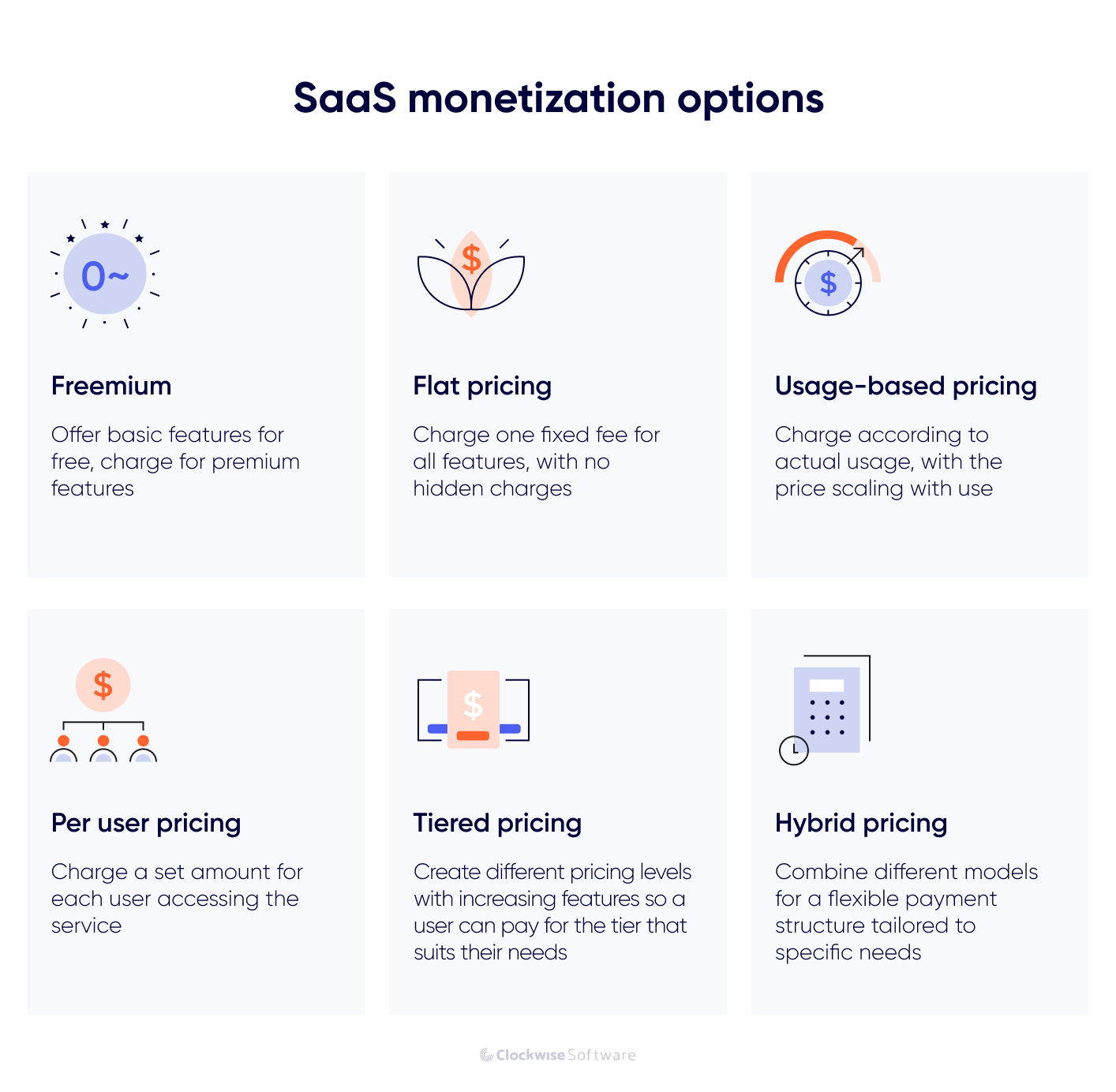
Key SaaS business model metrics
What can help you make the most of the SaaS business model? For sure, following SaaS trends and implementing user-oriented approaches during the SaaS product life cycle are important tasks on your way to success, but you shouldn’t forget about important SaaS business model metrics that can help you analyze and monitor your startup’s performance. Let’s consider the most important metrics in detail:
- Customer churn rate will help you evaluate which percentage of subscribers canceled or didn’t renew their subscriptions over a specific period. It should be tracked on a monthly or quarterly basis. User surveys and feedback analysis help identify reasons for a high churn rate.
- Customer lifetime value (CLV) helps in assessing the long-term value of acquiring a customer. It’s the predicted average amount of money a customer is expected to generate throughout their entire relationship with the company. This metric allows for understanding the value of your company.
- Customer acquisition cost (CAC) is the cost of acquiring a new customer. It includes marketing, sales, and other expenses. Ideally, this metric should be lower than CLV.
- Recurring revenue represents the total revenue generated on a monthly (MRR) or annual (ARR) basis. It helps analyze the performance of your business.
- Expansion revenue measures the additional revenue generated by existing customers. This is any revenue you get in excess of the user’s initial purchasing price. It helps in estimating overall growth of your business.
These metrics help you evaluate the success and health of your SaaS business, stimulate further growth, and track issues.
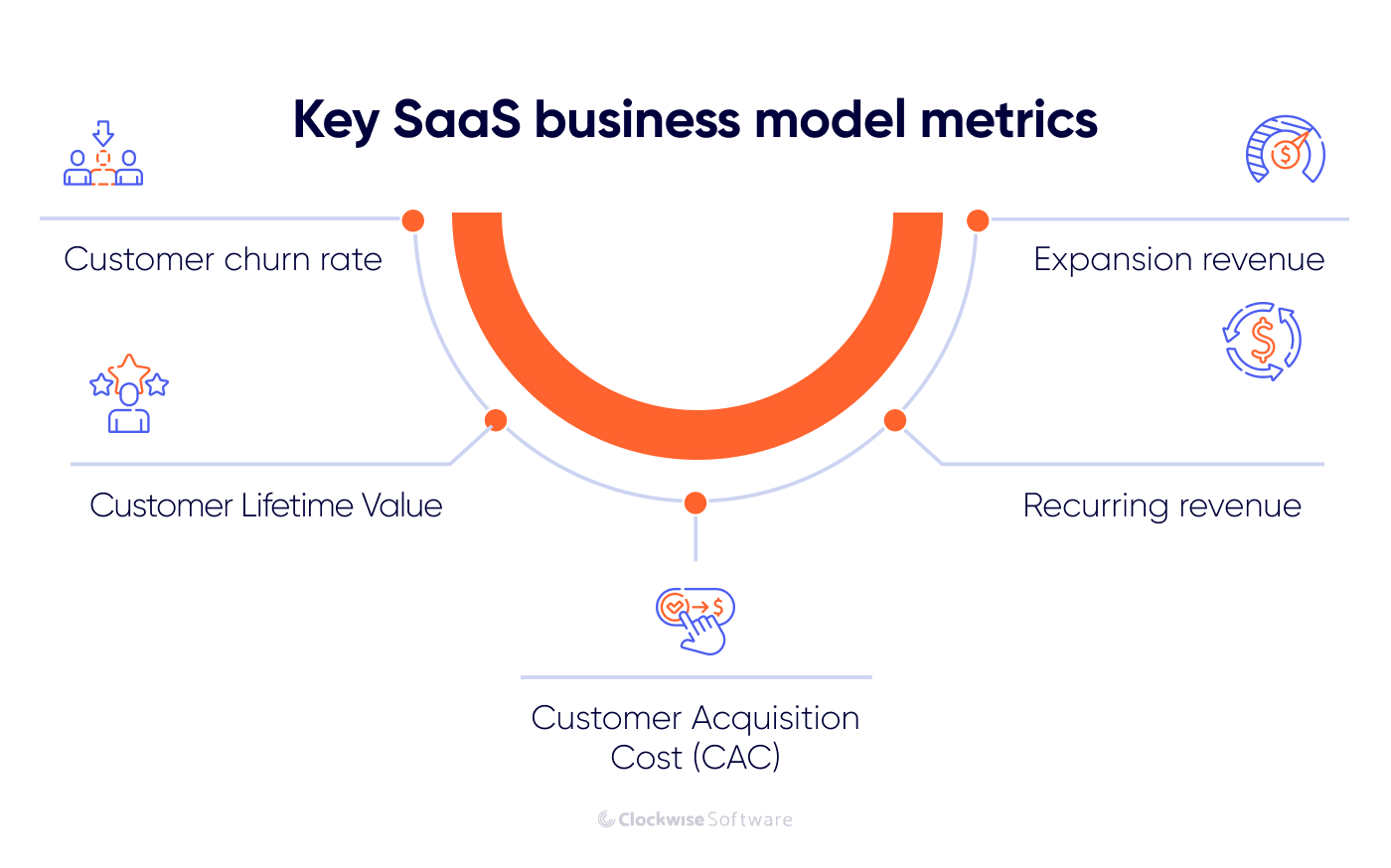
How to bring your SaaS business idea to life?
If you want to start a business based on SaaS business model, you need a team consisting of developers experienced in cloud computing, designers that can turn complex functionality into a user-friendly interface, a business analyst (BA) who can bridge the gap between technical and business requirements, QA engineers that can ensure flawless app performance, and a project manager (PM) who will lead the entire project.
Depending on your needs and the resources you currently possess, there are three possible ways to start bringing your SaaS business idea to life:
-
If an idea is all you have, make use of a software development consulting service. This option will work best if you need to prove your idea’s viability and find out how to move on with your project. In this scenario, you get access to expertise from a team of specialists that have broad SaaS experience. For example, in our company, you can consult with a team of SaaS development experts that are typically involved in the development process itself: backend and frontend developers, UI/UX designer, QA engineers, business analysts, and project managers.
As the outcome of software development consulting, your idea will be validated and you’ll receive a detailed development plan aligned with your goals, a reliable estimate of risks associated with your project, as well as a detailed custom app development cost estimation.
-
If you have a development team but lack technical leadership to properly build your SaaS app, get a Chief Technology Officer (CTO) as a Service. If you can’t deal with the technical side of your project, you may consider hiring a CTO as a service — a tech specialist or a team of tech specialists that will consult you on all tech-related questions and work for you on an on-demand (project) basis. Which type of architecture (multi-tenant or single-tenant) to choose for your app, what cloud provider to choose, how to select a technology stack, how to establish a software engineering team structure — you can answer all these questions with CTO as a Service. You can consult with your CTO before and during the development process.
You also can work with a company that provides Dedicated development team services to hire dedicated developers for your SaaS project that will work alongside your team on a project basis. They will provide the necessary tech expertise your developers lack.
-
If you want to focus on the business side and not dive into technical processes, outsource the development process. If the two services we mentioned above aren’t enough and you prefer to focus on the business side of the project, you can outsource your project to a software development company. An experienced development team will take over the work on your product, from planning and software requirements documentation right to the product launch. You, in turn, will only be involved as a key decision-maker and keep in touch with the PM to track the project's progress.
You may choose outsourcing software development to Ukraine or another Eastern European country where you can choose from a wide pool of highly qualified professionals and established software development companies with proven experience in various industries.
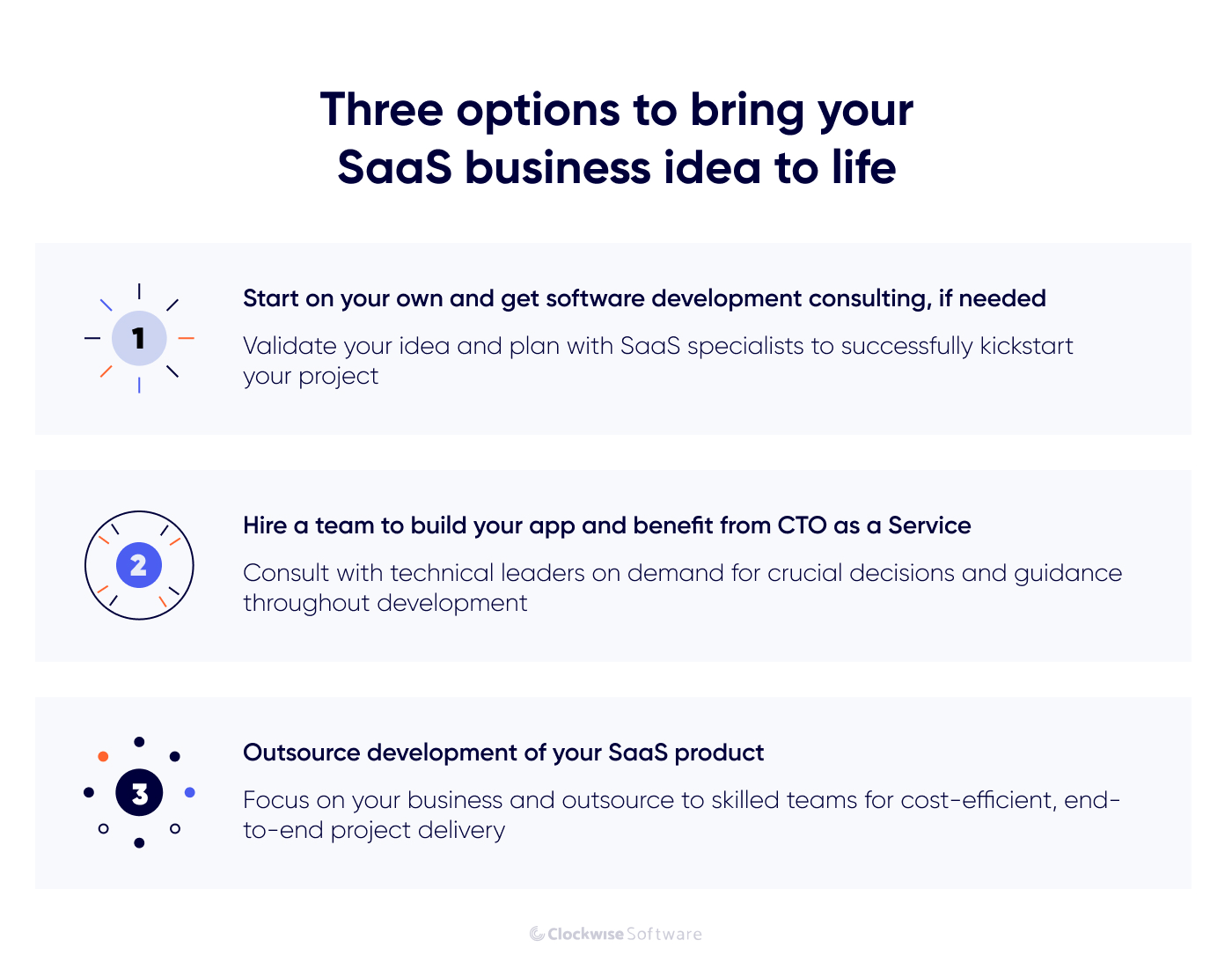
Implementing a SaaS business model: Clockwise Software’s experience
Clockwise Software has broad experience in SaaS product development. During more than eight years in the business, we have successfully completed dozens of SaaS projects, so we have a lot of stories to tell.
One of our most notable projects that shows the benefits of SaaS business model implementation is Whitelance.
Our client approached us with a functioning and successful freelancer marketplace platform. The client’s team discovered that there were a lot of founders willing to pay for using the platform’s functionality to start their own marketplaces.
The Clockwise Software team had to rewrite the web-based application’s architecture from scratch to enable it to serve multiple clients. For this, we implemented a multi-tenant architecture so each tenant (client) has access to a customized front end, unified back end, dedicated database, default set of features, and large library of advanced functionality. Thus, each Whitelance subscriber can have their own marketplace, choosing from ready marketing and brand materials to customize the app’s front end.
Now, Whitelance is a white-label freelance marketplace that lets people run their own Upwork-style platform. It offers services for companies, freelancers, and marketplace admins.
By partnering with Clockwise Software, Whitelance was able to turn their existing functionality with proven value into a new revenue stream by implementing a SaaS business model.
Conclusion
The SaaS business model offers plenty of benefits. Thanks to flexible and transparent pricing, accessibility and scalability, and automatic and regular updates, users are encouraged to stay loyal to your app and pay money for it on a regular basis.
To build a successful product following the SaaS business model, you need to pay attention to challenges associated with investments and market competition, choose the most beneficial monetization strategy for your product (freemium, usage-based, per-user, flat, or tiered), and opt for the most suitable way to bring your idea to life.
